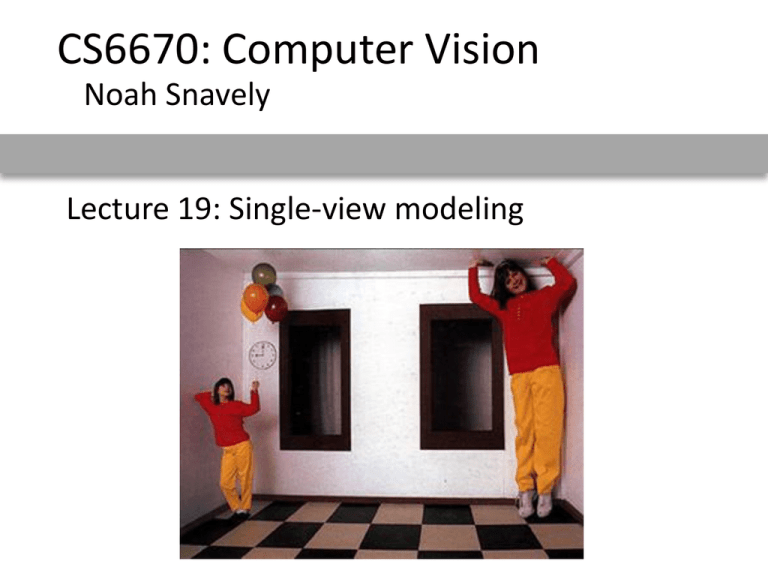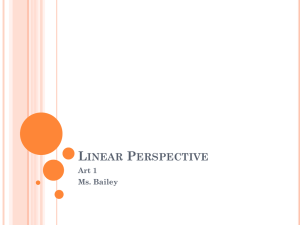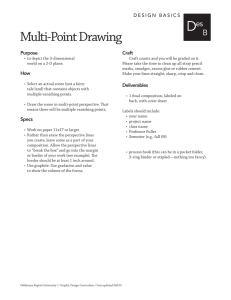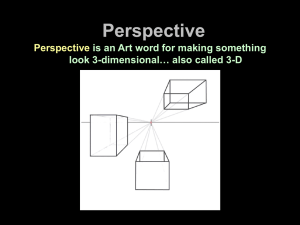ppt
advertisement

CS6670: Computer Vision Noah Snavely Lecture 19: Single-view modeling Announcements • Project 3: Eigenfaces – due tomorrow, November 11 at 11:59pm • Quiz on Thursday, first 10 minutes of class Announcements • Final projects – Feedback in the next few days – Midterm reports due November 24 – Final presentations tentatively scheduled for the final exam period: Wed, December 16, 7:00 PM - 9:30 PM Multi-view geometry • We’ve talked about two views 0 • And many views • What can we tell about geometry from one view? Projective geometry Ames Room Readings • Mundy, J.L. and Zisserman, A., Geometric Invariance in Computer Vision, Appendix: Projective Geometry for Machine Vision, MIT Press, Cambridge, MA, 1992, (read 23.1 - 23.5, 23.10) – available online: http://www.cs.cmu.edu/~ph/869/papers/zisser-mundy.pdf Projective geometry—what’s it good for? Uses of projective geometry • • • • • • Drawing Measurements Mathematics for projection Undistorting images Camera pose estimation Object recognition Paolo Uccello Applications of projective geometry Vermeer’s Music Lesson Reconstructions by Criminisi et al. Measurements on planes 4 3 2 1 1 2 Approach: unwarp then measure What kind of warp is this? 3 4 Image rectification p’ p To unwarp (rectify) an image • solve for homography H given p and p’ • solve equations of the form: wp’ = Hp – linear in unknowns: w and coefficients of H – H is defined up to an arbitrary scale factor – how many points are necessary to solve for H? Solving for homographies Solving for homographies Solving for homographies 2n × 9 9 2n Defines a least squares problem: • Since is only defined up to scale, solve for unit vector • Solution: = eigenvector of with smallest eigenvalue • Works with 4 or more points Point and line duality • A line l is a homogeneous 3-vector • It is to every point (ray) p on the line: l p=0 l p1 p2 l1 p l2 What is the line l spanned by rays p1 and p2 ? • l is to p1 and p2 l = p1 p2 • l can be interpreted as a plane normal What is the intersection of two lines l1 and l2 ? • p is to l1 and l2 p = l1 l2 Points and lines are dual in projective space • given any formula, can switch the meanings of points and lines to get another formula Ideal points and lines -y -z (a,b,0) -y (sx,sy,0) x image plane -z x image plane Ideal point (“point at infinity”) • p (x, y, 0) – parallel to image plane • It has infinite image coordinates Ideal line • l (a, b, 0) – parallel to image plane • Corresponds to a line in the image (finite coordinates) – goes through image origin (principle point) 3D projective geometry These concepts generalize naturally to 3D • Homogeneous coordinates – Projective 3D points have four coords: P = (X,Y,Z,W) • Duality – A plane N is also represented by a 4-vector – Points and planes are dual in 3D: N. P=0 – Three points define a plane, three planes define a point • Projective transformations – Represented by 4x4 matrices T: P’ = TP, N’ = T-T N 3D to 2D: “perspective” projection Projection: wx * * * * X p wy * * * * YZ ΠP w * * * * 1 Vanishing points (1D) image plane vanishing point camera center ground plane Vanishing point • projection of a point at infinity • can often (but not always) project to a finite point in the image camera center image plane Vanishing points (2D) image plane vanishing point camera center line on ground plane Vanishing points image plane vanishing point V camera center C line on ground plane line on ground plane Properties • Any two parallel lines (in 3D) have the same vanishing point v • The ray from C through v is parallel to the lines • An image may have more than one vanishing point – in fact, every image point is a potential vanishing point Two point perspective vy vx Three point perspective Vanishing lines v1 v2 Multiple Vanishing Points • Any set of parallel lines on the plane define a vanishing point • The union of all of these vanishing points is the horizon line – also called vanishing line • Note that different planes (can) define different vanishing lines Vanishing lines Multiple Vanishing Points • Any set of parallel lines on the plane define a vanishing point • The union of all of these vanishing points is the horizon line – also called vanishing line • Note that different planes (can) define different vanishing lines Computing vanishing points V P0 D P P0 tD Computing vanishing points V P0 D PX P Pt Y PZ Properties tDX PX tDY PY tDZ PZ 1 / t DX / t DY / t DZ 1/ t t v ΠP • P is a point at infinity, v is its projection • Depends only on line direction • Parallel lines P0 + tD, P1 + tD intersect at P P P0 tD DX D P Y DZ 0 Computing vanishing lines v1 C l l ground plane Properties • l is intersection of horizontal plane through C with image plane • Compute l from two sets of parallel lines on ground plane • All points at same height as C project to l – points higher than C project above l • Provides way of comparing height of objects in the scene v2 Fun with vanishing points Perspective cues Perspective cues Perspective cues Comparing heights Vanishing Point Measuring height How high is the camera? 5 4 3 2 1 5.4 Camera height 3.3 2.8 Computing vanishing points (from lines) v q2 q1 p2 p1 Intersect p1q1 with p2q2 Least squares version • Better to use more than two lines and compute the “closest” point of intersection • See notes by Bob Collins for one good way of doing this: – http://www-2.cs.cmu.edu/~ph/869/www/notes/vanishing.txt Measuring height without a ruler C Z ground plane Compute Z from image measurements • Need more than vanishing points to do this The cross ratio A Projective Invariant • Something that does not change under projective transformations (including perspective projection) The cross-ratio of 4 collinear points P3 P2 P1 P4 P3 P1 P4 P2 P3 P2 P4 P1 P1 P3 P4 P2 Can permute the point ordering P1 P2 P4 P3 • 4! = 24 different orders (but only 6 distinct values) This is the fundamental invariant of projective geometry Xi Y Pi i Zi 1 Measuring height TB R R B T H R scene cross ratio T (top of object) t b vZ r t r C vZ b R H (reference point) R B ground plane r b vZ t H R image cross ratio (bottom of object) X Y scene points represented as P Z 1 x image points as p y 1 Measuring height vz r vanishing line (horizon) t0 vx t vy v H R H b0 t b vZ r H r b vZ t R image cross ratio b Measuring height vz r vanishing line (horizon) t0 t0 vx vy v m0 t1 b1 b0 b What if the point on the ground plane b0 is not known? • Here the guy is standing on the box, height of box is known • Use one side of the box to help find b0 as shown above 3D Modeling from a photograph St. Jerome in his Study, H. Steenwick 3D Modeling from a photograph video by Antonio Criminisi 3D Modeling from a photograph Flagellation, Piero della Francesca 3D Modeling from a photograph video by Antonio Criminisi 3D Modeling from a photograph figure by Antonio Criminisi







